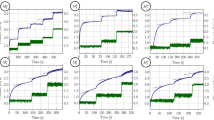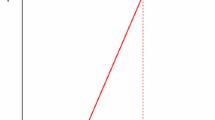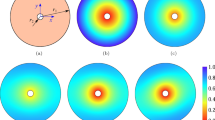Abstract
Using an analogy to the classical Stefan problem, we construct evolution equations for the fluid pore pressure on both sides of a propagating stress-induced damage front. Closed form expressions are derived for the position of the damage front as a function of time for the cases of thermally-induced damage as well as damage induced by over-pressure. We derive expressions for the flow rate during constant pressure fluid injection from the surface corresponding to a spherically shaped subsurface damage front. Finally, our model results suggest an interpretation of field data obtained during constant pressure fluid injection over the course of 16 days at an injection site near Desert Peak, NV.





Similar content being viewed by others
References
Aharonov, E., Anders, H.: Hot water: a solution to the Heart Mountain detachment problem? Geology 34, 165–168 (2006)
Barenblatt, G.I.: Scaling, Self-Similarity, and Intermediate Asymptotics. Cambridge University Press, Cambridge (1996)
Carslaw, H.S., Jaeger, J.C.: Conduction of Heat in Solids. Oxford University Press, New York (1959)
Chabora, E., Zemach, E., Spielman, P., Drakos, P., Hickman, S., Lutz, S., Boyle, K., Falconer, A., Robertson-Tait, A., Davatzes, N.C., Rose, P., Majer, E., Jarpe, S.: Hydraulic stimulation of well 27-15, Desert Peak Geothermal Field, Nevada. In: Proceedings 37th Workshop on Geothermal Reservoir Engineering, Stanford, SGP-TR-194 (2012)
Dusseault, M.B.: Geomechanical challenges in petroleum reservoir exploitation. J. Civ. Eng. 15, 669–678 (2011)
Geertsma, J., de Klerk, F.: A rapid method of predicting width and extent of hydraulically induced fractures. J. Petrol. Technol. 21, 1571–1581 (1969)
Gordeyev, Y.N., Zazovsky, A.F.: Self-similar solution for deep-penetrating hydraulic fracture propagation. Transp. Porous Med. 7, 283–304 (1992)
Jaeger, J.C., Cook, N.G.W., Zimmerman, R.W.: Fundamentals of Rock Mechanics. Blackwell, Malden (2007)
Kohl, T., Evansi, K., Hopkirk, R., Rybach, L.: Coupled hydraulic, thermal and mechanical considerations for the simulation of hot dry rock reservoirs. Geothermics 24, 345–359 (1995)
Lee, H.S., Cho, T.F.: Hydraulic characteristics of rough fractures in linear flow under normal and shear load. Rock Mech. Rock Eng. 35, 299–318 (2002)
Lewis, K.C., Zyvoloski, G.A., Travis, B., Wilson, C., Rowland, J.: Drainage subsidence associated with Arctic permafrost degradation. J. Geophys. Res. 117, doi:10.1029/2011JF002284 (2012)
Lockner, D.A., Tanaka, H., Ito, H., Ikeda, R., Omura, K., Naka, H.: Geometry of the Nojima Fault at Nojima-Hirabayashi, Japan—I. A simple damage structure inferred from borehole core permeability. Pure Appl. Geophys. 166, 1649–1667 (2009)
Mitchell, T.M., Faulkner, D.R.: Towards quantifying the matrix permeability of fault damage zones in low porosity rocks. Earth Planet. Sci. Lett. 339–340, 24–31 (2012)
Rubinstein, L.I.: The Stefan Problem. American Mathematical Society, Providence (1971)
Rutqvist, J., Stephansson, O.: The role of hydromechanical coupling in fractured rock engineering. Hydrol. J. 11, 7–40 (2003). doi:10.1007/s10040-002-0241-5
Voight, B., Elsworth, D.: Failure of volcano slopes. Geotechnique 47, 1–31 (1997)
Wijesinghe, A.M.: Similarity solution for coupled deformation and fluid flow in discrete fractures. In: International Conference on Radioactive Waste Management, Winnipeg, Manitoba, 7 Sep 1986. CONF-860910-2 (1986)
Yow, J.L., Hunt, J.R.: Coupled processes in rock mass performance with emphasis on nuclear waste isolation. Int. J. Rock Mech. Min. Sci. 30, 143–150 (2002)
Acknowledgments
This work was supported in part by the Department of Energy’s Fossil Energy Program through the National Energy Technology Laboratory, and by the US DOE Office of Geothermal Technologies under Work Authorization No. GT-100036-12_Revision 1, EERE Agreement No. 25316. This support is greatly appreciated. Satish Karra thanks U.S. Department of Energy for the support through the geothermal Project DE-EE0002766. The authors would also like to acknowledge insightful review and comments by David Dempsey that led to significant improvements.
Author information
Authors and Affiliations
Corresponding author
Appendix: Justification for Neglecting \(\nabla \rho \)
Appendix: Justification for Neglecting \(\nabla \rho \)
Substituting (2.2), (2.3), and (2.4) into (2.1) yields
with
Dividing (6.1) by the term proportional to \(\nabla ^2 p\) leads to the dimensionless equation
Now consider a small vertical section of porous material of height \(\Delta z\) over which the pressure varies by amount \(\Delta p\), and suppose the time variation of \(p\) over an interval of time \(\Delta t\) is equal to \(\xi \Delta p\) for some constant \(\xi \). Then the first term on the left hand side is in order of magnitude
where we have assumed that \(\rho _0/\rho \approx 1\) and that the order of \(\nabla ^2 p\) is \(\Delta p/\Delta z^2\). Term (6.4) is not in general small compared to unity. The third term has order of magnitude
and due to the smallness of \(\beta \), only approaches unity for very large values of \(\Delta z\). The fourth term varies as
and is small compared to unity except for very large values of \(\Delta p\). Therefore, for the parameter regime of interest in this study, the dominant balance in Eq. (6.1) is between the first and second terms on the left hand side.
Rights and permissions
About this article
Cite this article
Lewis, K.C., Karra, S. & Kelkar, S. A Model for Tracking Fronts of Stress-Induced Permeability Enhancement. Transp Porous Med 99, 17–35 (2013). https://doi.org/10.1007/s11242-013-0171-9
Received:
Accepted:
Published:
Issue Date:
DOI: https://doi.org/10.1007/s11242-013-0171-9




